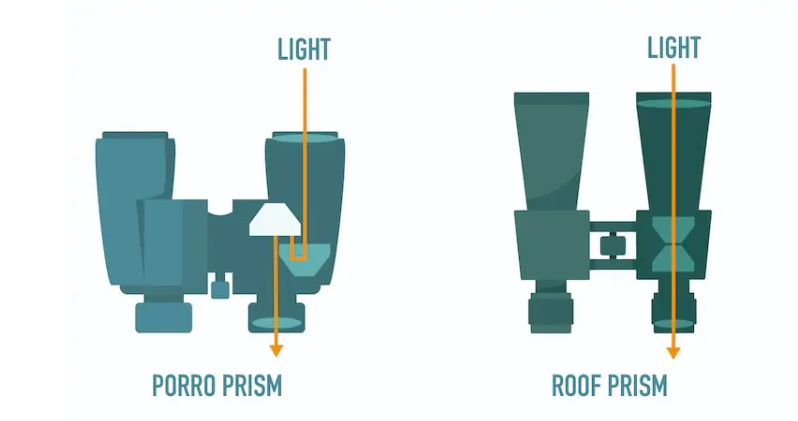How Do Prisms Work in Binoculars?
Before we can really get into how prisms work in binos, we need to first understand what they are. By definition, a prism in optics is a transparent object — particularly one that is triangular in construction, that refracts light against its surfaces in order to separate white light into the spectrum of colors.
Now, that’s a mouthful. Let’s take a look into what that really means.
Prisms in binoculars are simple blocks of glass that act as mirrors. The keyword here is “act”. They are not true mirrors like you would find in a telescope. True mirrors have a reflective backing whereas prisms do not. Mirrors also produce a true image of what is being observed and not a virtual image created through light bending.

Porro Prisms
This type of prism set is the first set of prisms used in modern-day binoculars. They were first developed in the 19th century by Italian Ignazio Porro and are still being used to this day.
Porro Prisms work by sending the light captured by your objective lens through a pair of prisms in a quick horizontal movement. The movement between prisms acts as an amplifier and inverter to send a magnified and orientation corrected image of your target through the ocular lenses.
Porro prism binoculars are extremely easy to differentiate from other binos due to their zigzag or offset shape. This alone can make Porro prisms much heavier and more awkward to use than other binocular sets. And they’re a bit more fragile. However, they can give you a much clearer 3D image than other binocular sets along with a much larger field of vision.
But despite the zigzag, they’re actually the simplest binocular set design — which means they’re much cheaper to produce. And those savings very often get passed down to you, the consumer.
You’ll probably want to use Porro prism binoculars whenever you’re needing that extra clear image or wider FOV. They’re great for shorter range birding, hunting, sporting events, and general outdoor use.
Roof Prisms
If you see a pair of straight tube binoculars, there’s a good chance you’re looking at a set equipped with Roof prisms.
These are the more modern of the two types of binoculars. They’re more compact and streamlined, lighter weight, and much easier to carry around than the bulky Porro-style binos. And at first glance, they look to be more simplified as well.
However, such is not the case.
Their internal machinations are actually the most complex out of any other binocular style. And that’s because there’s no easy horizontal zig or zag. Remember, the movement of the light is what amplifies and inverts it as it reflects off the prisms. So, Roof prisms take advantage of intricate and convoluted machined paths that reflect the light from the objective to ocular lenses.
But this sequence isn’t complex for just for complexity’s sake. The light movement through Roof prisms can actually allow for much higher magnification powers and brighter end imagery.
The thing is though, they can get quite pricey. And that’s because they cost much more to make with all the specialty internal machining.




